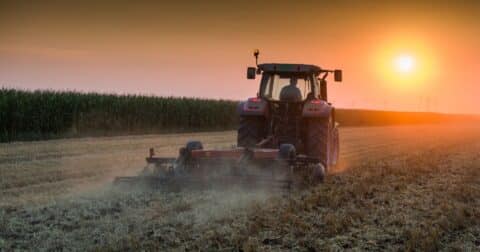News
Sentient Impact Report 2025
Policy•1 min read
Explainer
How they differ — and what’s at stake — explained.


Words by Seth Millstein
Congress is in the process of reauthorizing the Farm Bill, a quinquennial package of legislation that undergirds American farming and agriculture. The Farm Bill is a regular source of partisan bickering in Washington, and as usual, the Democratic and Republican Farm Bill proposals have some pretty huge differences that the parties will need to reconcile. Let’s take a look at them.
The Farm Bill is a large and complex piece of legislation that governs, regulates and provides funding for a wide variety of government programs relating to farming, agriculture and the environment. It has to be reauthorized by Congress around every five years, and given the enormous role that it plays in facilitating America’s food systems, it’s considered a “must-pass” piece of legislation.
Whenever the time comes to reauthorize the Farm Bill, Democrats and Republicans in Congress argue about what the latest version should contain. Normally, the two parties are able to reconcile their differences before the previous version of the bill expires, and pass a new version that will cover the next five years.
In 2023, however, Congress couldn’t come to an agreement on a long-term Farm Bill before the 2018 bill was set to expire. Instead, they extended the 2018 bill for another year. That extension expires in September, and Congress is racing to pass a new Farm Bill before then.
There are two different versions of the Farm Bill being debated: the Democratic proposal and the Republican proposal. Both parties released summaries of their respective versions in May, although as of this writing, only Republicans have unveiled the full text of their proposal.
The Democratic version is being proposed in the Senate, as that’s the chamber of Congress that Democrats control, while the Republican proposal is originating in the GOP-controlled House of Representatives. The House Agriculture Committee approved the Republican version of the bill on May 24, with a vote that mostly tracked party lines.
Before getting into the points of contention, it’s worth noting that there’s quite a bit of farm policy that the two parties agree on.
Both the Democratic and Republican plans would increase funding for the USDA’s conservation programs, an anti-wildfire initiative known as the Good Neighbor Authority, and federal programs that help bring broadband Internet to rural areas. Both would make Americans who’ve been convicted of drug-related felonies eligible to receive food stamps (they currently aren’t), and both would expand the types of crops eligible for federal crop insurance subsidies.
But although there’s a lot of crossover between the two proposals, there are some important differences as well.
The federal food stamps program — officially the Supplemental Nutrition Assistance Program, or SNAP — is authorized and contained in the Farm Bill. An important part of the social safety net for low-income Americans, SNAP funding is usually one of the most contentious parts of the Farm Bill. In recent years, Republicans have attempted to cut SNAP funding when it’s time to reauthorize the Farm Bill, while Democrats have attempted to retain or increase it.
That’s what’s happening this time, too. Normally, SNAP payments are regularly adjusted to account for changes in food prices, cost of living, nutritional guidance and some other factors. The GOP’s Farm Bill would freeze SNAP payments at their current levels and prevent any future increases.
Republicans in the House deny that this constitutes a “cut,” as it doesn’t enact any immediate reduction. But SNAP payment amounts have been increasing in recent years, and according to an analysis by the Center on Budget and Policy Priorities, the GOP’s proposed freeze would effectively cut future SNAP payments by $30 billion over the next 10 years.
The Democratic bill, by contrast, contains no such freeze on SNAP increases, and would allow the USDA to continue adjusting SNAP payments over time. As mentioned earlier, both parties’ proposals would allow Americans convicted of drug-related felonies to be eligible for SNAP benefits.
In 2018, California voters approved Proposition 12, which does two things. It bans the extreme confinement of livestock produced in California, and prohibits the in-state sale of animal products that were produced using extreme confinement in other states. The meat industry sued to overturn the proposition but the Supreme Court upheld it, and it went into effect in January of this year.
The Republican Farm Bill would gut Proposition 12, however, by making it illegal for states to enforce “any condition or standard of production on products derived from covered livestock not physically raised in such State.” This would effectively nullify the second half of Proposition 12, and prevent any other states from enacting similar restrictions in the future. A number of Republican leaders have consistently pledged to reverse Prop 12 with federal legislation, and U.S. Department of Agriculture Secretary Tom Vilsack warned allowing Prop 12 to stand would cause “chaos” in the market.
The Democratic Farm Bill contains no such language, and would not water-down Proposition 12.
The Inflation Reduction Act of 2022 authorized 13 billion dollars for the USDA’s conservation programs, which help farmers pay for projects that protect the health of the land they farm on. The only catch was that this money could only be spent on programs that offer some benefit to the climate as well.
Both the Democratic and Republican versions of the bill include this increased funding. The Republican version, however, would remove the requirement that these programs benefit the climate, and additionally, would authorize the USDA to take a broader definition of “conservation” when enacting new programs (though it doesn’t specify what should be added to this definition).
This has emerged as one of the most contentious parts of the Republican bill, as the “climate-smart” funding in the 2022 law was considered an enormous win for the environment. The Democratic Farm Bill retains the 2022 guidelines for conservation programs, requiring the additional money to be spent on climate-related projects.
The Commodity Credit Corporation (CCC) is a government-owned and operated financial institution created in 1933 to stabilize and support the American farming industry. The CCC is managed by the Department of Agriculture, and offers financial, infrastructural and material support to agricultural producers in various ways.
The Republican Farm Bill would significantly restrict the activities of the CCC by requiring the USDA to get congressional authorization before using CCC funds. According to Secretary of Agriculture Tom Vilsack, this would severely limit the USDA’s ability to respond promptly to natural disasters, as the agency often uses CCC money to help producers recover after such disasters.
Before the Farm Bill can become law, the House and Senate — and by extension, Republican and Democratic lawmakers — will need to reconcile their two different visions for the Farm Bill, and craft a compromise version that can pass both chambers.
The question, then, is not which version of the Farm Bill will pass, but rather, which provisions will survive in the final bill, and which ones won’t.
That’s a very difficult thing to predict in normal circumstances, and it’s even harder here: each chamber of Congress is controlled by a different party, and each party only has a razor-thin majority in their respective chamber. Because of how small these majorities are, passing any bill in either chamber will be difficult — let alone passing a later version that the other chamber also agrees on.
This will be a protracted process, and there’s no way of knowing exactly what type of compromise the two parties will come to. Having said that, Democrats seem to have a slight upper hand in the Farm Bill battle, for two reasons.
For one, Democrats control the White House. This means that the final bill, whatever it looks like, will have to be palatable to Joe Biden, a Democrat — or it could be vetoed.
Secondly, although Republicans technically control the House of Representatives, there’s been so much infighting lately within the GOP that the party’s leadership has been relying on Democratic votes to pass legislation. This trend is so pronounced that it’s even led some to call Democratic Rep. Hakeem Jeffries, who’s technically the minority leader, the “shadow Speaker” of the House.
Over a dozen House Republicans have already expressed opposition to certain elements of their party’s Farm Bill — specifically, the provisions that gut Proposition 12 (over concern that state agricultural policy shouldn’t be overridden by congressional law). As a result, the GOP will almost certainly need some Democratic votes to pass the bill, and Democrats are unlikely to lend their support unless Republicans drop some of the most controversial provisions in their version of the bill.
It’s much too early to predict what the final Farm Bill will look like. Democrats haven’t released the full text of their proposal yet, and though the Republican version has been approved by the House Agriculture Committee, that was mostly thanks to Republican support. Neither version has yet been scored by the Congressional Budget Office, the non-partisan government agency tasked with calculating the budgetary impacts of major legislation.
The previous Farm Bill extension expires on September 23rd, and if the past is any indicator, lawmakers will be arguing and negotiating right up until that deadline.